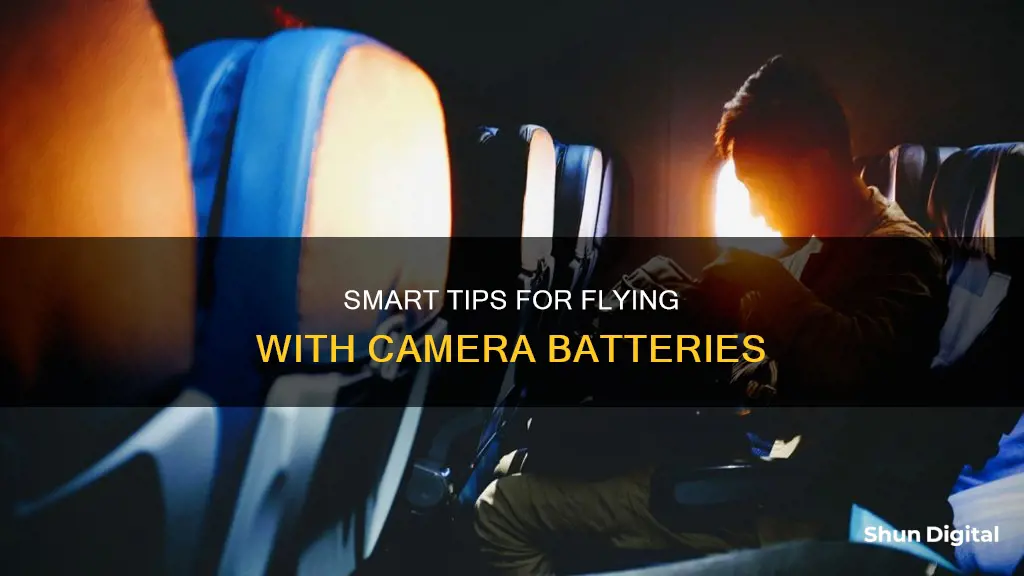
Packing camera batteries for a flight can be a stressful experience, especially given the fire risk posed by lithium-ion batteries. However, with some careful planning, you can ensure your trip goes smoothly. First, it's important to note that lithium-ion camera batteries are allowed on planes, but they must be stored in carry-on luggage. This is because, in the event of a fire, having the batteries in the cabin means you or another passenger can take action to extinguish it. To prevent short-circuiting, you should also tape over the charging interface or connectors of your batteries. It's also a good idea to store your batteries in their original packaging or a protective case, or place tape across the battery's contacts to isolate the terminals.
| Characteristics | Values |
|---|---|
| Where to pack | Carry-on luggage |
| Battery type | Lithium-ion |
| Battery quantity | No limit for small dry cells; 2 spare lithium-ion batteries; 20 in total as an absolute maximum |
| Battery capacity | Under 100Wh; up to 160Wh with airline certification |
| Battery condition | Not damaged, e.g. no swelling or leakage |
| Packaging | Original retail packaging; protective case; plastic bag; tape across battery contacts |
| Weight | Must not exceed airline weight limit |
What You'll Learn

Tape battery terminals to prevent short circuits
When flying with camera equipment, it's important to take precautions to ensure the safety of yourself and those around you. This is especially true when it comes to packing camera batteries, as lithium-ion batteries are considered dangerous goods due to their potential to short-circuit or catch fire. To prevent short circuits, one essential step is to tape the battery terminals.
Firstly, it's crucial to understand the risks associated with lithium-ion batteries. In the context of air travel, the primary concern is the possibility of a short circuit, which can lead to overheating and, in extreme cases, cause a fire. Therefore, taking steps to prevent short circuits is of utmost importance.
Now, let's delve into the specifics of taping battery terminals. The goal here is to create a barrier that prevents the positive terminal from coming into direct contact with the negative terminal, as this could result in uncontrolled energy release and overheating. By using tape, you're adding an insulating layer that physically separates the terminals.
When taping your camera battery terminals, it's important to use the right type of tape. Avoid using duct tape or parcel tape, as these can leave behind sticky residue or marks on your batteries. Instead, opt for camera tape or gaffer's tape, which provide strong adhesion without leaving any residue. Electrical tape, also known as insulating tape, is another suitable option.
When applying the tape, make sure to cover both the positive and negative terminals completely. You can cut small pieces of tape and carefully place them over each terminal, ensuring that the tape adheres securely. Alternatively, you can use the manufacturer's original packaging, which often includes plastic covers or terminal caps designed to protect the battery contacts.
In addition to taping the terminals, there are a few other precautions you should take when packing camera batteries for air travel. Always carry your lithium-ion batteries in your hand luggage or carry-on bag, as storing them in checked baggage is prohibited. Additionally, it's a good idea to keep the batteries in their original packaging or a protective case to facilitate customs checking and prevent damage.
By following these guidelines and paying close attention to the latest regulations, you can ensure that your camera batteries are packed safely and securely for air travel. Remember, staying up to date with the latest rules and regulations regarding battery transportation is essential, as these guidelines can change over time.
The Cost of Capturing Moments: Camera Charging Explained
You may want to see also

Pack batteries in original packaging
When flying with camera batteries, it's important to follow the guidelines provided by the airline and aviation authorities. Lithium-ion camera batteries are typically allowed on flights, but there are specific rules to ensure safety.
If you're packing camera batteries in their original packaging, here are some detailed instructions to follow:
- Check the latest regulations: Before your trip, it's wise to check the guidelines of your airline and the relevant aviation authorities, such as the FAA, TSA, EASA, or IATA. These guidelines may change over time, so staying up to date is crucial.
- Prepare the original packaging: Ensure that the original packaging is intact and undamaged. If the packaging is damaged or missing, refer to the alternative packing methods outlined below.
- Inspect the batteries: Only bring batteries that are in good condition. Do not pack damaged, swollen, or leaking batteries. If you notice any abnormalities, dispose of the batteries properly and purchase new ones.
- Quantity and capacity limits: Pay attention to the quantity and capacity limits for camera batteries. Typically, you can carry two large lithium-ion batteries (between 101 and 150/160 Wh) and an unlimited number of batteries below 100 Wh, provided they are not for resale.
- Protect the battery terminals: To prevent short circuits, it is recommended to tape over the charging interface or connections of the batteries. You can use camera tape to avoid leaving any sticky residue on the batteries.
- Marking and customs: Marking your camera batteries can facilitate the customs checking process. Some customs officials may inquire about your devices and power sources, and having them in their original packaging can make identification easier.
- Carry-on luggage: It is generally recommended to carry camera batteries in your carry-on luggage. This allows you to monitor the batteries and respond to any potential issues. However, always check your airline's specific policies, as some may have different requirements.
- Additional safety measures: To further enhance safety, consider storing the batteries in separate bags or protective cases within your carry-on luggage. This provides an extra layer of protection and makes it easier to access the batteries during your travels.
By following these instructions, you can help ensure that your camera batteries are packed safely and securely when flying.
Polaroid Camera Battery Requirements: What You Need to Know
You may want to see also

Keep batteries in carry-on luggage
Keeping batteries in your carry-on luggage is the recommended way to transport them when flying. This is because, in the cabin, airline crew can monitor the batteries and address any issues that may arise. It is also important to note that some batteries are prohibited in checked baggage.
When packing your camera batteries, ensure that they are shielded from harm and short circuits. You can do this by storing them in their original packaging or taping over the charging interface or terminals. This will also prevent the batteries from being activated accidentally during the flight. The TSA recommends placing tape over the battery's contacts to isolate the terminals.
It is also important to note that only certain types of batteries are allowed on planes. Lithium-ion batteries, such as those found in cameras, are allowed but must be within 100Wh. Each passenger can bring up to two spare lithium-ion camera batteries on the plane. For lithium-ion batteries over 100Wh but less than 160Wh, you will need to obtain airline clearance before bringing them on board.
In addition to following the guidelines set by the TSA, it is also important to check with your specific airline, as they may have their own limitations and guidelines for carrying batteries.
Charging Nixon Camera Batteries: A Step-by-Step Guide
You may want to see also

Limit the number of lithium-ion batteries
Lithium-ion batteries are a common power source for many modern gadgets, such as cameras, cell phones, laptops, and tablets. However, due to their potential to short-circuit or catch fire, they are considered dangerous goods. As a result, there are strict guidelines for carrying them on airplanes.
Firstly, it is important to limit the number of lithium-ion batteries you bring with you. Each passenger is typically allowed to carry only two spare lithium-ion camera power sources on the plane. This restriction applies to both installed and spare batteries. If you need to bring more, you may be able to get permission from the airline, but it is best to check with them before your trip to ensure you are following their specific guidelines.
Secondly, when packing lithium-ion batteries, always use carry-on luggage. Do not put them in your checked baggage. This is because, in the rare event of a fire, having the batteries in the cabin allows the crew and passengers to address the issue promptly. Additionally, the cargo hold's temperature and pressure variations may cause the batteries to malfunction or ignite.
To further reduce the risk of fire, it is crucial to protect the battery terminals. Tape over the charging interface or connectors, or use the original packaging, to prevent accidental activation and short circuits during transportation.
Finally, always inspect your batteries before packing them. Do not bring damaged, defective, or recalled batteries on the plane, especially if they are likely to overheat or catch fire. By following these guidelines, you can help ensure a safe journey for yourself and your fellow passengers.
Charging Your Coolpix S51: A Step-by-Step Guide
You may want to see also

Use protective cases or plastic bags
When packing camera batteries for air travel, it is important to take precautions to ensure the safety of the batteries and compliance with airline regulations. One essential step is to use protective cases or plastic bags to shield the batteries from damage and prevent short circuits.
Protective cases and plastic bags serve as a physical barrier between the battery terminals and other metal objects in your luggage. By isolating the battery terminals, you reduce the risk of accidental contact and short circuits, which could lead to a fire hazard. This protective measure is especially crucial for lithium-ion batteries, which are commonly used in camera equipment and are known for their potential to short-circuit or catch fire.
When preparing your camera batteries for air travel, you have a few options for protective cases or plastic bags:
- Original Packaging: If possible, store your batteries in their original retail packaging. This packaging is designed to protect the batteries during transport and prevent unintentional activation.
- Plastic Bags: If you don't have the original packaging, place each battery in its own plastic bag, such as a small ziplock bag. This will insulate the battery terminals and prevent contact with other batteries or metal objects.
- Protective Cases: You can also purchase protective cases specifically designed for storing camera batteries. These cases provide a secure and safe way to transport your batteries, ensuring that the terminals are protected.
- Tape: As an additional precaution, you can cover the battery terminals with tape. This creates a barrier between the terminals and any potential sources of contact, further reducing the risk of short circuits.
By using protective cases or plastic bags, you can safely transport your camera batteries and comply with airline regulations. It is important to remember that the safety of travellers and crew members is a top priority, so taking these extra steps to secure your batteries is well worth the effort.
ZS50: In-Camera Charging Supported?
You may want to see also
Frequently asked questions
You can carry two spare lithium-ion camera power sources on the airplane. However, there is no restriction on the number of small dry cells that you can check in your luggage or carry in your carry-on.
Standard AA or AAA alkaline cells are allowed without any limitations. Installed lithium-ion batteries, such as LP-E6 and NP-F series batteries, are subject to different requirements and should be carried in carry-on baggage.
It is recommended that you store your batteries in their original retail packaging to prevent unintentional activation or short-circuiting. If the original packaging is unavailable, isolate the battery terminals by placing tape across the contacts or storing each battery in its own protective case or plastic bag.
It is advised to carry camera batteries in your carry-on luggage due to the possibility of malfunction or ignition due to variations in cargo hold temperature and pressure. Spare lithium-ion batteries are prohibited in checked baggage.







